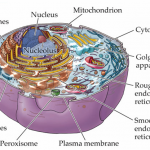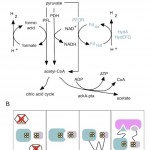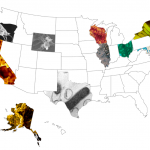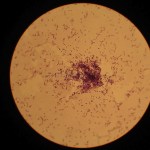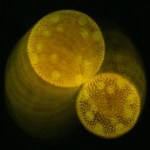bacteria
Animal cells are made up of many smaller membrane-bound compartments called organelles that perform highly specialized functions necessary for life. Incredibly, several of these organelles have been shown to be evolutionarily related to free-living bacteria, captured and incorporated inside a larger cell billions of years ago in a complex mutually beneficial relationship, known as endosymbiosis (a partnership between two species where one of the species is inside the other). The mitochondria that power our cells, generating energy by breaking down sugars are in fact relatives of regular old…
The Not Exactly Pocket Science experiment continues after the vast majority of people who commented liked the pilot post. I'm really enjoying this, for quite unexpected reasons. It's forcing me to flex writing muscles that usually don't get much of a workout. Writing short pieces means being far more economical with language and detail than usual. It means packing in as much information as possible while still keeping things readable. And it means blitz-reading papers and writing quickly without losing any accuracy.
One quick note before the good stuff: last time, a few people suggested that…
My paper, "Insulation of a synthetic hydrogen metabolism circuit in bacteria" just came out in the Journal of Biological Engineering! And it's open access!
We designed a metabolic circuit in bacteria that produces hydrogen (a potentially useful fuel) from natural precursors in the cell. The proteins in our synthetic pathway work to make hydrogen by transferring high-energy electrons from pyruvate, a common metabolite, to protons that are freely floating in the watery cytoplasm. The electrons transfer between the proteins through quantum-mechanical tunneling, which makes hydrogenases and…
You are outnumbered by a factor of 10 to one, by forces you cannot see. Your body has around ten trillion cells, but it's also home to a hundred trillion bacteria. For every gene in your genome, there are 100 bacterial ones. Most of these are found the dark, dank environment of your bowel but their incredible diversity is being brought to the surface. Say hello to the gut metagenome.
Together with a team of international scientists, Junjie Qin and Ruiqiang Li from BGI-Shenzen had the unenviable task of studying the bacteria from the faeces of 124 Europeans. They used a formidable and…
Sure, this is old, but I hadn't seen a video quite this cool before. Behold, a human polymorphonuclear leukocyte (PMN, or neutrophil) on a blood film, "chasing" Staphylococcus aureus.
There are more videos of cells in action here.
It never ceases to amaze me how cells can detect biochemical gradients over such short distances and use them for navigation. I'm sure I'll find it just as fascinating right up until the day I can't think of science anymore.
I've had some great suggestions for "Official" State Microbes in comments and via twitter. I'm filling in the map as they come:
So far we have:
Alaska -- Alcanivorax borkumensis for its oil consumption
California -- Ralstonia metallidurans for its gold precipitating qualities (and CA-MRSA as a terrifying runner up)
Illinois -- Penicillium roqueforti for its blue cheese making
Maryland -- Chlamydia trachomatis for UMD research on the bug
Massachusetts -- Escherichia coli for its importance to biotech
New York -- Pseudomonas putida, the first organism to be the subject of a patent case, which…
Wisconsin lawmakers just passed a bill to name Lactobacillus lactis, the bacteria that turns milk into cheese, into its official state microbe! What microbe do you think best represents your state? I think Massachusetts' state microbe should be E. coli, not for the gross make you sick part of course, but because of the importance of the biotech industry to Massachusetts and the importance of the lowly E. coli to biotech. Add your vote for your state microbe in the comments!
tags: synthetic biology, molecular biology, genetics,Bacteria make Mexican Waves, A synchronized quorum of genetic clocks, bacteria, fluorescence,biological clock, NPG, peer-reviewed research, NATURE, 10.1038/nature08753, streaming video
By synchronizing our clocks, we can coordinate our activities with people around the world. Now, scientists have genetically engineered bacteria to synchronize their molecular timekeepers, creating the stunning fluorescent waves that you see in this video (this video shows new research published today in NATURE).
Read the original research here: http://dx.…
This is an updated version of the first post I wrote this year. The scientists in question were looking at ways of recruiting bacteria in the fight against mosquito-borne diseases, such as dengue fever. They've just published new results that expand on their earlier experiments.
Mosquitoes are incredibly successful parasites and cause millions of human deaths every year through the infections they spread. But they are no match for the most successful parasite of all - a bacterium called Wolbachia. It infects around 60% of the world's insect species and it could be our newest recruit in the…
Cephalotes grandinosus, an herbivorous ant
Why are there so many ants?
This is a more perplexing question than it may seem. At first glance ants are predators and scavengers. Yet predators should be few in number, balanced on a narrow trophic peak and depending on high prey biomass to exist. Why are terrestrial ecosystems dominated by these little hunters?
A landmark study several years ago by Dinah Davidson provided an answer: many ants are not predators at all. They're herbivores. Sure, they snack now and again on flesh. But ants get most…
Hardly a natural history documentary goes by without some mention of leafcutter ants. So overexposed are these critters that I strongly suspect they're holding David Attenborough's relatives to ransom somewhere. But there is good reason for their fame - these charismatic insects are incredibly successful because of their skill as gardeners.
As their name suggests, the 41 species of leafcutter ants slice up leaves and carry them back to their nests in long columns of red and green. They don't eat the leaves - they use them to grow a fungus, and it's this crop that they feed on. It's an old…
As a species, we hate cheaters. Just last month, I blogged about our innate desire to punish unfair play but it's a sad fact that cheaters are universal. Any attempt to cooperate for a common good creates windows of opportunity for slackers. Even bacteria colonies have their own layabouts. Recently, two new studies have found that some bacteria reap the benefits of communal living while contributing nothing in return.
Bacteria may not strike you as expert co-operators but at high concentrations, they pull together to build microscopic 'cities' called biofilms, where millions of individuals…
The prospect of infections spreading from animals to humans has become all too real with the onset of the current swine flu pandemic, and the threat of a bird flu still looming. But infections can jump the other way too. Decades before the world's media were gripped with panic over bird flu, humans transferred a disease to chickens and it has since caused a poultry pandemic right under our noses.
The infection in question is a familiar one - Staphylococcus aureus, a common human bacterium that's behind everything from mild skin infections to life-threatening MRSA. It causes chicken…
This article is reposted from the old Wordpress incarnation of Not Exactly Rocket Science. The blog is on holiday until the start of October, when I'll return with fresh material.
Science fiction loves to play off the potential threat of threat of alien viruses. But a new study suggests that space travellers are much more likely to be threatened by germs from our own planet that become more virulent in space.
Warding off infections is a real priority for astronauts, especially if longer space missions to the Moon and Mars are to go ahead. People have a tendency to get sick in space and…
The drawers of the world's museums are full of pinned, preserved and catalogued insects. These collections are more than just graveyards - they are a record of evolutionary battles waged between animals and their parasites. Today, these long-dead specimens act as "silent witnesses of evolutionary change", willing to tell their story to any biologist who knows the right question to ask.
This time round, the biologist was Emily Hornett, currently at UCL, and her question was "How have the ratios of male butterflies to female ones changed over time?" You would think that the sex ratios of…
Viruses and bacteria often act as parasites, infecting a host, reproducing at its expense and causing disease and death. But not always - sometimes, their infections are positively beneficial and on rare occasions, they can actually defend their hosts from parasitism rather than playing the role themselves.
In the body of one species of aphid, a bacterium and a virus have formed a unlikely partnership to defend their host from a lethal wasp called Aphidius ervi. The wasp turns aphids into living larders for its larvae, laying eggs inside unfortunate animals that are eventually eaten from…
When the bacteria that cause anthrax (Bacillus anthracis) aren't ravaging livestock or being used in acts of bioterrorism, they spend their lives as dormant spores. In these inert but hardy forms, the bacteria can weather tough environmental conditions while lying in wait for their next host. This is the standard explanation for what B.anthracis does between infections, and it's too simple by far. It turns out that the bacterium has a far more interesting secret life involving two unusual partners - viruses and earthworms.
A dying animal can release up to a billion bacterial cells in every…
In the darkness of the deep ocean, some animals create their own light. Among these is the Hawaiian bobtail squid Euprymna scolopes, which forms a partnership with the luminous bacterium Vibrio fischeri. The squid houses colonies of these bacteria in special light organs, and it can control the brightness and direction of their illuminations. But these organs do much more than produce light - they detect it too.
Deyan Tong from the University of Wisconsin has discovered that the organs generate nervous signals when they sense light and they're loaded with proteins responsible for detecting…
It's a diverse melting-pot of different groups, with hundreds of different cultures living together in harmony, many sticking to their own preferred areas. No, not London, New York or any other cosmopolitan city; I'm talking about your skin. It may all look the same to you, but to the bacteria living on it, it's an entire realm of diverse habitats.
From a microscopic perspective, the hairy, moist surface of your armpits is worlds apart from the smooth, dry skin of your forearms. Even though they are separated by mere inches, these patches of skin are as different to their microscopic…
by Katie the Lowly Intern
Researchers at Cambridge University have debunked the long standing myth that freshwater algae can't dance. Volvox, while sounding like a herpes medication for mad scientists, is a spherical algae organism made up of only about 1,000 cells. They get their swerve from their flagella (think sperm tails) which they wag around until they create a flow of fluid. This flow of fluid causes them to stay in bound movements with each other; one movement being called a "waltz" and the other a "minuet." Scientists think that the oscillating dance moves make it easier for the…
